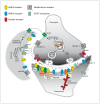Glutamate receptor abnormalities in schizophrenia: implications for innovative treatments
- PMID: 24116269
- PMCID: PMC3792192
- DOI: 10.4062/biomolther.2012.20.1.001
Glutamate receptor abnormalities in schizophrenia: implications for innovative treatments
Abstract
Schizophrenia is a devastating psychiatric illness that afflicts 1% of the population worldwide, resulting in substantial impact to patients, their families, and health care delivery systems. For many years, schizophrenia has been felt to be associated with dysregulated dopaminergic neurotransmission as a key feature of the pathophysiology of the illness. Although numerous studies point to dopaminergic abnormalities in schizophrenia, dopamine dysfunction cannot completely account for all of the symptoms seen in schizophrenia, and dopamine-based treatments are often inadequate and can be associated with serious side effects. More recently, converging lines of evidence have suggested that there are abnormalities of glutamate transmission in schizophrenia. Glutamatergic neurotransmission involves numerous molecules that facilitate glutamate release, receptor activation, glutamate reuptake, and other synaptic activities. Evidence for glutamatergic abnormalities in schizophrenia primarily has implicated the NMDA and AMPA subtypes of the glutamate receptor. The expression of these receptors and other molecules associated with glutamate neurotransmission has been systematically studied in the brain in schizophrenia. These studies have generally revealed region- and molecule-specific changes in glutamate receptor transcript and protein expression in this illness. Given that glutamatergic neurotransmission has been implicated in the pathophysiology of schizophrenia, recent drug development efforts have targeted the glutamate system. Much effort to date has focused on modulation of the NMDA receptor, although more recently other glutamate receptors and transporters have been the targets of drug development. These efforts have been promising thus far, and ongoing efforts to develop additional drugs that modulate glutamatergic neurotransmission are underway that may hold the potential for novel classes of more effective treatments for this serious psychiatric illness.
Keywords: Accessory proteins; Antipsychotics; Ionotropic; Metabotropic; Modulators.
Figures

Similar articles
-
Glutamatergic neurotransmission modulators as emerging new drugs for schizophrenia.Expert Opin Emerg Drugs. 2005 Nov;10(4):827-44. doi: 10.1517/14728214.10.4.827. Expert Opin Emerg Drugs. 2005. PMID: 16262565 Review.
-
Molecular abnormalities of the glutamate synapse in the thalamus in schizophrenia.Ann N Y Acad Sci. 2003 Nov;1003:75-93. doi: 10.1196/annals.1300.005. Ann N Y Acad Sci. 2003. PMID: 14684436 Review.
-
Expression of the ionotropic glutamate receptor subunits and NMDA receptor-associated intracellular proteins in the substantia nigra in schizophrenia.Brain Res Mol Brain Res. 2004 Feb 5;121(1-2):60-9. doi: 10.1016/j.molbrainres.2003.11.004. Brain Res Mol Brain Res. 2004. PMID: 14969737
-
Beyond dopamine: glutamate as a target for future antipsychotics.ISRN Pharmacol. 2012;2012:427267. doi: 10.5402/2012/427267. Epub 2012 Jul 5. ISRN Pharmacol. 2012. PMID: 22830044 Free PMC article.
-
Dopamine-glutamate interaction and antipsychotics mechanism of action: implication for new pharmacological strategies in psychosis.Curr Pharm Des. 2005;11(27):3561-94. doi: 10.2174/138161205774414538. Curr Pharm Des. 2005. PMID: 16248808 Review.
Cited by
-
N-linked glycosylation of cortical N-methyl-D-aspartate and kainate receptor subunits in schizophrenia.Neuroreport. 2013 Aug 21;24(12):688-91. doi: 10.1097/WNR.0b013e328363bd8a. Neuroreport. 2013. PMID: 23820740 Free PMC article.
-
Altered Glutamate and Regional Cerebral Blood Flow Levels in Schizophrenia: A 1H-MRS and pCASL study.Neuropsychopharmacology. 2017 Jan;42(2):562-571. doi: 10.1038/npp.2016.172. Epub 2016 Aug 26. Neuropsychopharmacology. 2017. PMID: 27562377 Free PMC article.
-
Histamine H2 receptor deficit in glutamatergic neurons contributes to the pathogenesis of schizophrenia.Proc Natl Acad Sci U S A. 2023 Feb 28;120(9):e2207003120. doi: 10.1073/pnas.2207003120. Epub 2023 Feb 22. Proc Natl Acad Sci U S A. 2023. PMID: 36812204 Free PMC article.
-
The Effects of Acupuncture on Glutamatergic Neurotransmission in Depression, Anxiety, Schizophrenia, and Alzheimer's Disease: A Review of the Literature.Front Psychiatry. 2019 Feb 12;10:14. doi: 10.3389/fpsyt.2019.00014. eCollection 2019. Front Psychiatry. 2019. PMID: 30809158 Free PMC article. Review.
-
Fifty Years of Research on Schizophrenia: The Ascendance of the Glutamatergic Synapse.Am J Psychiatry. 2020 Dec 1;177(12):1119-1128. doi: 10.1176/appi.ajp.2020.20101481. Am J Psychiatry. 2020. PMID: 33256439 Free PMC article. Review. No abstract available.
References
-
- Arai A. Kessler M. Rogers G. Lynch G. Effects of a memory-enhancing drug on DL-alpha-amino-3-hydroxy-5-methyl-4-isoxazolepropionic acid receptor currents and synaptic transmission in hippocampus. J. Pharmacol. Exp. Ther. (1996);278:627–638. - PubMed
Publication types
LinkOut - more resources
Full Text Sources

